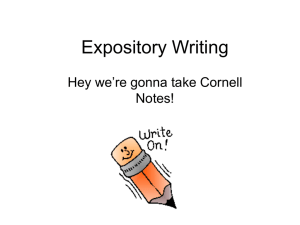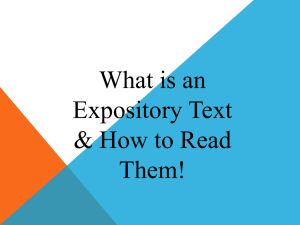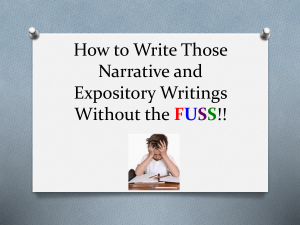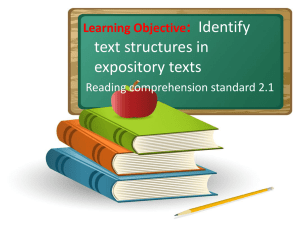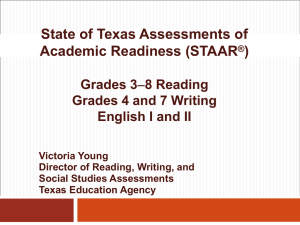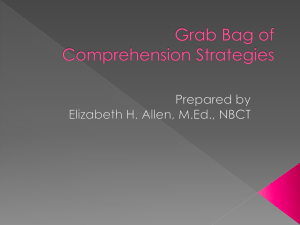Professional Development Project Part I
advertisement
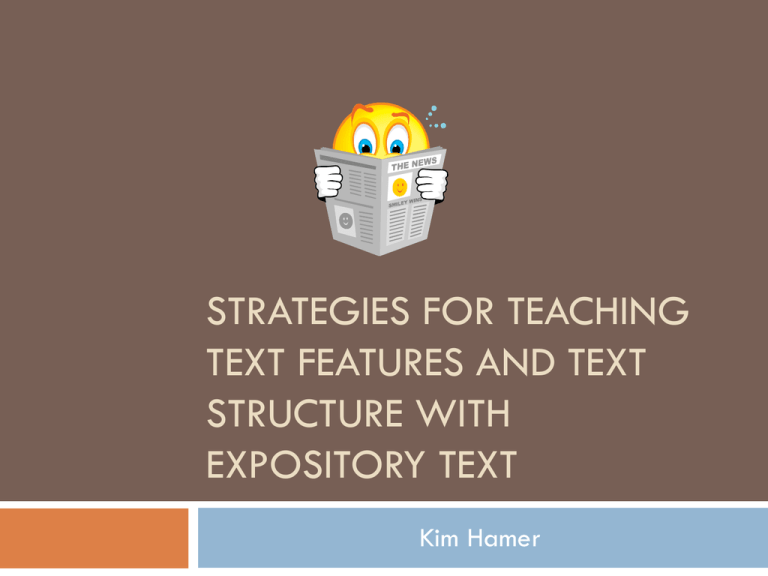
STRATEGIES FOR TEACHING TEXT FEATURES AND TEXT STRUCTURE WITH EXPOSITORY TEXT Kim Hamer Understanding Yourself, As a Reader How do you use text features to aid your comprehension as you read? What strategies do you use to help you understand these text features? Do you employ the same strategies when you read different types of expository texts? How does the organizational structure of the text impact how you read it? Please Reflect On The Following Quotes “Expository text and strategic reading are particularly important, given the current emphasis on assessing reading achievement.” - Paola Pilonieta (2011) “Young children lack early exposure to exposition.” - Barbara Moss (2004) “Students have not been taught to read expository text.” - Barbara Moss (2004) Classroom Connection Please take a minute to think about the following questions: - How much expository text do you implement in your classroom? - Do you have age appropriate examples of authentic expository text for children? - What are some ways that you explicitly teach students to read and understand expository text? Interesting Statistics “Between 2,500 and 5,000 new children’s nonfiction books are published each year, more than any other genre.” - Barbara Moss (2004) “It can be detrimental to students’ academic achievement if they are not exposed to a variety of reading material.” - Paola Pilonieta (2011) “In a study involving more than 100 hours of observations in primary literacy classrooms, there was not a single instance of teachers modeling reading strategies for reading expository text.” - Barbara Moss (2004) What Can We, As Educators Do To Change Things How can we change the way our students perceive, read, comprehend, and interact with expository text? Text Features and Text Structure Can Help!! “Text features include all the components of a story or article that are not the main body of text. These include the table of contents, index, glossary, headings, bold words, sidebars, pictures, and captions, and labeled diagrams.” -Kelley, Clausen-Grace (2010) The structure or organization of the text is the arrangement of ideas and the relationships among the ideas.” Text structures include description, sequence, compare/contrast, cause/effect, and problem/solution. -Akhondi, Malayeri, and Samad (2011) The Importance of Understanding Text Features “Expository nonfiction also contains numerous text features that supplement and present important content that the student must read in order to fully comprehend. Interestingly thought, students often ignore these essential text features, even though they have been taught their importance.” -Kelley, Clausen-Grace (2010) Strategies To Use When Teaching Text Features The Text Feature Picture Walk (Kelley, Clausen-Grace, 2010) Understanding Text Features of Different Genres (Bluestein, 2010) We will explore these strategies in more detail during a later session. The Text Feature Walk Why is the picture walk effective when teaching young children how to preview text? What strategies do you use when teaching your students how to preview expository text? Please take a moment and predict what a text feature walk is. What do you think this strategy looks like and sounds like? The Text Feature Walk Students work to explore and become familiar with the text features in a certain text, before actually reading the text. Students use these text features in helping them to make predictions about the text, and in determining the main idea. In order for students to successfully implement this strategy, the text feature walk must be taught using the gradual release of responsibility. Classroom Connection What are your ideas for incorporating a text feature walk into your instruction? Think about what this strategy will look like and sound like in your classroom. Text Features and Genres “We must begin to create a bridge to expository text comprehension for our neediest readers by scaffolding instruction of the most common features of three genres of nonfiction. -Bluestein (2010) Text Features and Genres Please reflect on the following questions. What types of expository text do you use in your classroom? Does your classroom library offer students a variety of genres? Text Features and Genres Biography -table of contents, index, timelines, photographs, captions Journalistic Text Genre - pictures, captions, charts, maps, graphs Informational Text/Textbooks Genre - table of contents, headings/subheadings, bold words, summary statements The Importance of Understanding Text Structure “The ability to identify and analyze these text structures in expository texts help readers to comprehend the text more easily and retain it longer.” -Akhondi, Malayeri, and Abd Samad (2011) Types of Text Structure Description Sequence Compare/Contrast Cause/Effect Problem/Solution Strategies For Teaching Text Structure “Introduce text structure in order, beginning with description, and finishing with compare/contrast.” “Do not combine text structures.” Practice one text structure until students are comfortable with it. (It helps if the texts are short when students are practicing.) Highlight/Find signal words Introduce students to graphic organizers Scaffolding with blank graphic organizers Have students practice writing with the designated text structure. - Akhondi, Malayeri,and Abd Samad (2011) Expository Texts and Trade books According to Barbara Moss (2004), information trade books and using them to retell events from the text, will help students begin to understand how different texts are organized. Expository Texts and Trade books When selecting expository trade books, teachers should consider - the age level and interests of students - the readability of the book - the text structure being taught Classroom Connection What expository trade books do you currently use in your classroom? Which text structure could you use to teach with these books? How would you evaluate these books in terms of being appropriate and capturing the interests of your students? Resources for Finding Authentic Expository Texts and Trade books http://www.ala.org/mgrps/divs/alsc/awardsgrants/ bookmedia/sibermedal/idex.cfm Robert F. Siebert Award http://www.reading.org/Resource/Booklists/TeacherC hoices.aspx Reading Teacher’s Teacher Choice Booklist http://www.ala.org/ala/mgrps/divs/alsc/awardsgra nts/notalists/ncbindex.cfm ALA’s Notable Children’s Books Thank You For Coming! Next session, we will look at expository trade books in more depth, as well as choosing authentic expository texts. I am looking forward to continue learning with you! References Akhondi, M., Malayeri, F., & Samad, A. (2011). How to Teach Expository Text Structure to Facilitate Reading Comprehension. Reading Teacher, 64(5), 368-372. doi:10.1598/RT.64.5.9 Bluestein, N. (2010). Unlocking Text Features for Determining Importance in Expository Text: A Strategy for Struggling Readers. Reading Teacher, 63(7), 597-600. Kelley, M. J., & Clausen-Grace, N. (2010). Guiding Students Through Expository Text With Text Feature Walks. Reading Teacher, 64(3), 191-195. doi:10.1598/RT.64.3.4 Moss, B. (2004). Teaching expository text structures through information trade book retellings. Reading Teacher, 57(8), 710-718. Pilonieta, P. (2011). The expository text primer: A teacher's resource guide for using expository text. New England Reading Association Journal, 46(2), 45-51.
